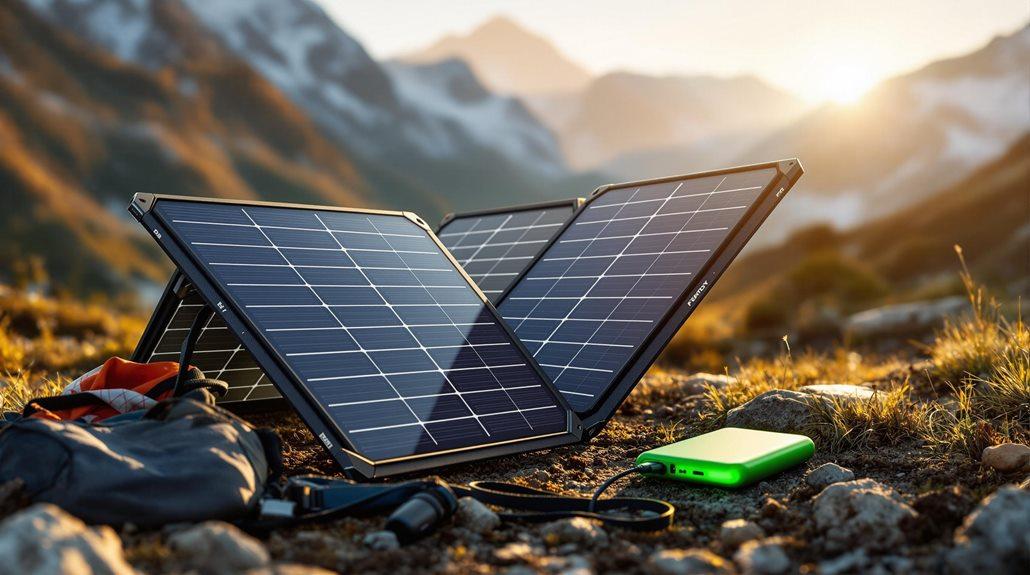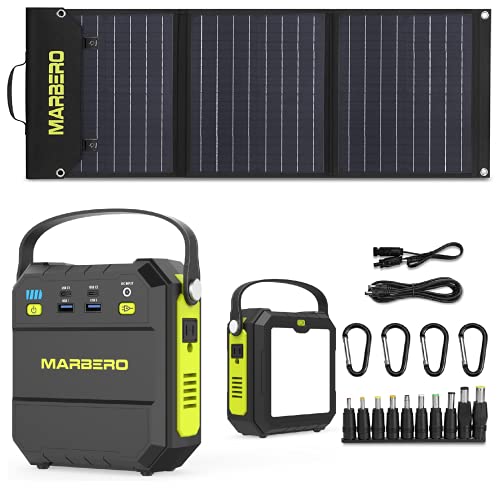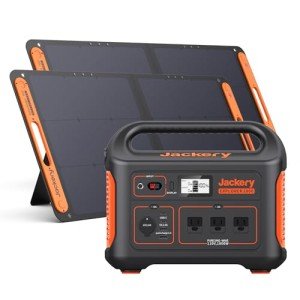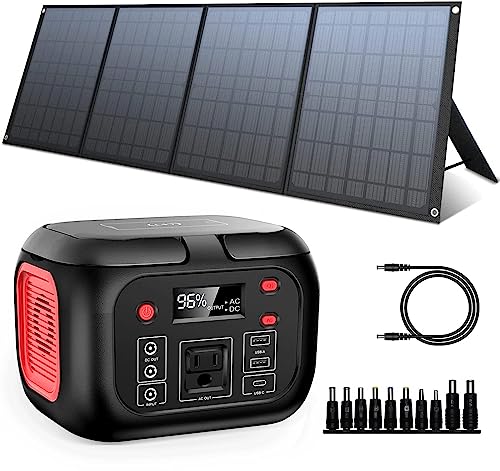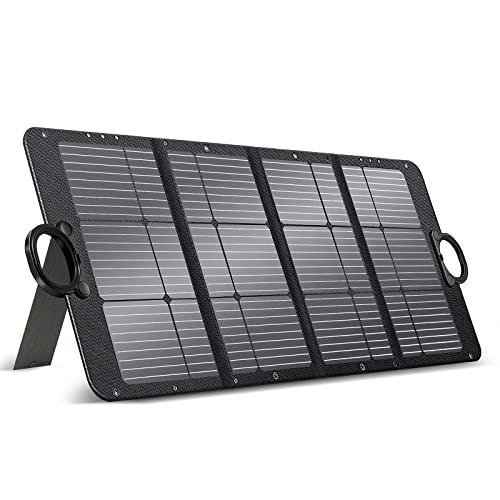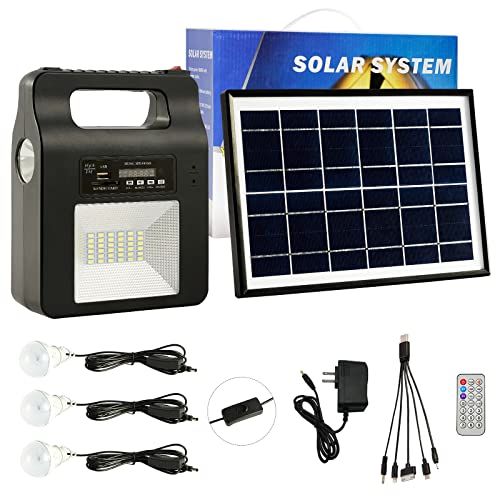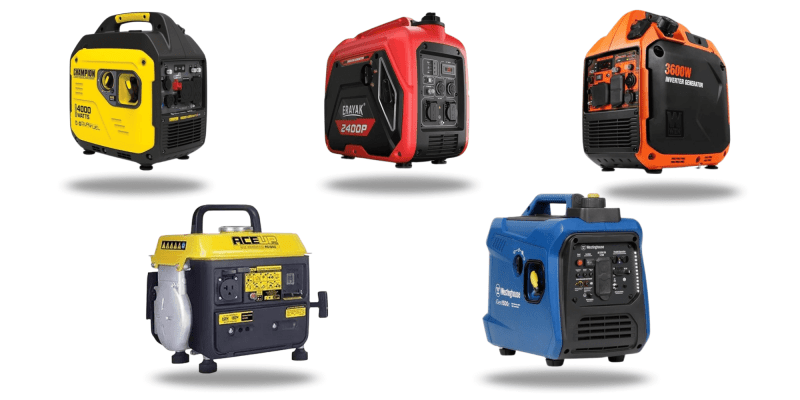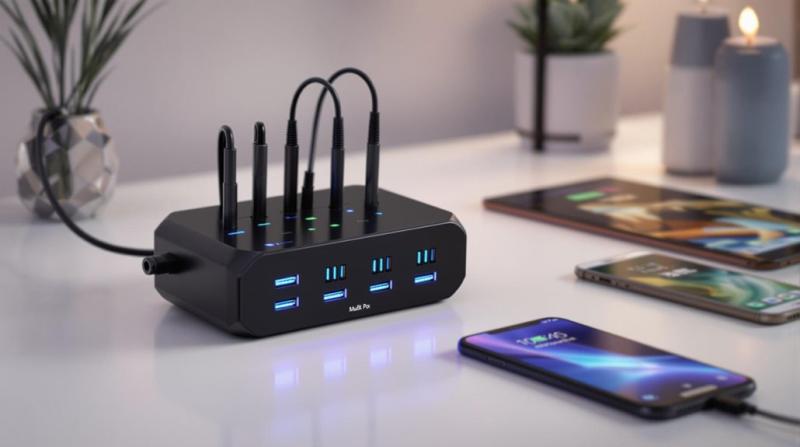Today's top portable solar generators offer impressive power for on-the-go needs. The Jackery Explorer 2000 Plus leads with 6000W surge power and expandable batteries, while the Anker Solix F3800 matches that output with extensive expansion options. For budget-conscious buyers, the Bluetti AC70 delivers reliable 768Wh capacity at $429. Most units feature lithium batteries, charge fully within 45-90 minutes via wall outlets, or 3-8 hours using solar panels. You'll want to choose a generator with at least 20% more capacity than your total device requirements. The latest models pack advanced features that'll transform your outdoor power experience.
Key Takeaways
- Jackery Explorer 2000 Plus leads portable solar generators with 6000W surge capacity and expandable battery options.
- Optimal solar charging requires direct sunlight, 45-degree panel angle facing south, and temperatures between 59-95°F.
- Portable solar generators range from 240Wh to 2,048Wh capacity, with prices spanning $350 to $900.
- Modern units feature LiFePO4 batteries, reinforced casings, and water-resistant ports for durability in various environments.
- Most solar generators can fully charge in 45-90 minutes via wall outlet or 3-8 hours with solar panels.
Best Solar Generator Models
Leading the portable solar power market in 2024, several standout generators offer diverse solutions for different energy needs. The Jackery Explorer 2000 Plus combines impressive battery capacity with RV-ready functionality, featuring expandable battery options and robust AC outlets for versatile power output. reliable for camping trips, its ability to handle surge capacities up to 6000W makes it exceptional for extended outdoor adventures. You'll find its 25A AC output particularly useful for demanding applications.
For those seeking maximum power, the Anker Solix F3800 delivers an exceptional 6,000W output, with lithium battery expansion potential reaching 26.9kWh. If you're working with a tighter budget, the Bluetti AC70 provides reliable performance at $429, offering 768Wh with proven 93% usable capacity. The compact BougeRV Flash300 stands out among portable power stations with its rapid 45-minute solar charging capability and 600W output, making it ideal for shorter trips or emergency backup.
The Jackery Explorer 1000 Plus hits the sweet spot for many users, delivering 2,000W of power and 1,264Wh capacity. You can expand its capabilities with up to three additional batteries, making it adaptable to your changing power needs while maintaining efficient solar panel compatibility.
Power Output Comparisons
Understanding power output capacities helps you select the right solar generator for your specific needs. Solar power stations come in various sizes, offering outputs from 300 watts for basic charging needs to 3,000 watts for more demanding applications. When comparing portable generators, lithium battery advantages make them substantially lighter and more efficient than traditional lead-acid options, with better capacity retention over time. When you're comparing portable generators, you'll want to weigh both continuous power and peak output capabilities.
The Jackery Explorer 1000, with its 1,000-watt continuous power output, represents a mid-range option that's ideal for running multiple devices simultaneously. For lighter charging needs, models like the Bluetti AC70 deliver 768Wh capacity, while high-end systems such as the Anker Solix F3800 can provide up to 6,000W of energy output. You'll find that most generators offer double their rated capacity for surge power, handling brief high-draw moments of 2,000-2,400 watts.
To match your devices with the right generator, contemplate that most laptops and small electronics require a minimum of 200-300 watts. For peak performance, add up the power requirements of all devices you plan to use simultaneously, then choose a generator that exceeds your total power needs by at least 20%.
$229.98
$154.99
4.69 out of 5 starsMARBERO Solar Power Station with Panel Kit
Unleash the Power of the Sun with MARBERO's Solar-Powered Portable Generator and Panel Kit
Product information
Product Review Score
Product links
Battery Life and Charging Times
Battery capacity plays a pivotal role in portable solar generator performance, with most models offering between 300 and 2,400 watt-hours of storage. Premium models like the Goal Zero Yeti deliver exceptional capacity for extended off-grid use. When you're selecting a portable power station, you'll need to evaluate both battery life and charging times to match your specific needs. Modern lithium iron phosphate batteries have revolutionized charging efficiency, with premium models achieving 80% capacity in just 1.5 hours through a wall outlet.
You'll find that charging speed varies substantially depending on your power source. Wall outlets provide the fastest option at 45-90 minutes, while solar charging typically takes 3-8 hours with proper sunlight exposure. To maximize your generator's lifespan, you'll want to maintain the charge between 20-80% and avoid complete discharge. When using solar panels, expect charging efficiency of 75-80% of the panel's rated capacity - for instance, a 400W panel can fully charge a 2,000 watt-hours of capacity unit in 4-6 hours of direct sunlight. Understanding these charge time variables will help you plan accordingly and verify your power station remains ready when you need it most.
Durability in Outdoor Conditions
Engineered for extreme environments, modern portable solar generators incorporate LiFePO4 battery chemistry and rugged construction to withstand nature's toughest challenges. You'll find these high-performance units can handle temperature variations from -4°F to 104°F, guaranteeing reliable outdoor performance whether you're camping in winter or hiking during summer months. Pure sine wave technology provides essential protection for sensitive devices while maximizing energy efficiency during operation.
The durability of today's solar generators comes from their thoughtful design features. Leading models utilize reinforced polymer casings and aluminum frames that protect internal components from impacts, scratches, and dust infiltration. You'll notice shock-absorbing corners and water-resistant sealed ports that keep moisture and debris out during outdoor adventures. These rugged features aren't just for show - they've been proven through extensive testing across diverse environmental conditions.
Manufacturers like Jackery Explorer and Anker SOLIX have subjected their units to over 100 individual evaluations to verify temperature resistance and long-term durability. When you're selecting a portable solar generator, look for these protective elements to guarantee your investment will maintain consistent performance regardless of the outdoor conditions you encounter.
Size and Portability Features
Modern portable solar generators come in an impressive array of sizes to match every power need and lifestyle. Whether you're a minimalist backpacking enthusiast or need substantial power for extended trips, you'll find options ranging from pocket-sized 50-watt panels to robust 200-watt systems. The BougeRV Flash300 model offers impressive fast charging capabilities, reaching full power in just 45 minutes for enhanced convenience.
For those prioritizing lightweight mobility, models like the Jackery Explorer 300 weigh just 7.1 pounds, making them ideal for outdoor adventures where every ounce matters. The dimensions of these compact units won't overwhelm your pack, while still delivering reliable power when you need it. If you're looking for more substantial power, larger units feature convenient telescoping handles and durable wheels for easy transportation.
When selecting your portable solar station, you'll want evaluate both panel size and wattage requirements. Compact 240Wh units serve well for basic needs, while expansive 2,048Wh systems handle more demanding power requirements. Today's manufacturers have mastered the balance between power capacity and portability, engineering designs that maintain efficient performance without sacrificing mobility. You'll find thoughtfully designed units that can move easily from campsite to backyard, ensuring reliable power wherever your adventures take you.
Solar Panel Efficiency Ratings
Understanding efficiency ratings helps you select the most effective portable solar solution for your needs. When you're looking at portable solar panel options, you'll find efficiency ratings typically range from 15% to 22%, with monocrystalline panels delivering the highest performance at 20-22% energy conversion rates.
To get the most charging power from your solar setup, consider investing in monocrystalline technology, which you'll find in top pick brands like Jackery and Goal Zero. These premium panels convert more sunlight into usable watts of solar energy, delivering consistent backup power even in varying conditions. For peak power generation, you'll want to position your panels at the correct sunlight angle, keeping them perpendicular to the sun's rays whenever possible.
Temperature also plays a pivotal role in solar panel efficiency, with peak performance occurring between 59-95°F. Under ideal conditions, a high-quality 400-watt panel can generate 200-300 watts of actual power output. When shopping for portable panels, focus on those with efficiency ratings above 20%, as they'll provide faster charging and more reliable energy conversion for your outdoor power needs.
4.11 out of 5 starsJackery Solar Generator 1000, 1002Wh Capacity with 2xSolarSaga 100W Solar Panels, 3x1000W AC Outlets, Portable Power Station Ideal for Home Backup, Emergency, RV Outdoor Camping
The Ultimate Power Solution for All Your Outdoor Adventures
Product information
Product Review Score
Product links
Setup and Operating Instructions
Setting up your portable solar power system starts with choosing the right location and positioning your panels correctly. For maximum efficiency, place your solar panels at a 45-degree angle facing south, where they'll receive the most direct sunlight throughout the day. This prime positioning guarantees you'll achieve the highest possible charging rates for your power station.
Once you've positioned your panels, connect them to your portable power station using the appropriate cables. You'll need to verify that your solar panel's wattage matches your power station's input specifications, which typically range from 100 to 800 watts. Make sure to properly align the MC4 or manufacturer-specific cables, paying close attention to the correct polarity during setup.
Keep an eye on your power station's LED display while charging. It'll show you important information like solar input watts, battery percentage, and estimated charging time. For peak performance, operate your system within recommended temperature ranges of 32-104°F. Most portable solar setups achieve complete charging within 2-6 hours, depending on your panel's output and environmental conditions. Remember to avoid extreme weather conditions that could affect charging efficiency or damage your equipment.
Price Point Analysis
Now that you've learned how to set up your solar power system, let's talk money. Portable solar generators come in a wide range of prices, typically starting at $350 for entry-level models and reaching up to $900 for premium units. Your investment will directly correlate with the power capacity you're seeking, as larger batteries and more efficient charging capabilities drive up costs.
For budget-conscious buyers, the Bluetti AC70 offers an affordable option at $429, delivering 768Wh capacity with impressive 93% usable power. If you're looking for a midrange solution, the Jackery Explorer 1000 Plus, priced around $800, provides substantial 1,264Wh capacity that's ideal for extended outdoor adventures. While the initial cost might seem steep, these solar panels and battery systems offer long-term savings compared to traditional gas generators.
When selecting your portable power station, consider how much capacity you'll actually need. Smaller 300Wh units under $500 work well for basic charging needs, while larger 2,000Wh+ models ranging from $800-$1,500 support more demanding power requirements. Your choice should balance cost with your specific power demands.
Frequently Asked Questions
What Is the Top Portable Solar Power Station?
You'll find the Jackery Explorer 2000 Plus leading the pack in portable performance and solar innovation. This power transformation powerhouse offers expandable battery integration and delivers exceptional charging efficiency through its compact design. With RV-ready 25A AC output and energy mobility features, it's revolutionizing renewable technology for outdoor resilience. The lightweight solutions and versatile capabilities make it your best choice for reliable, portable solar power in 2024.
What Is the Best Solar Power Bank for Power Outage?
For your peace of mind during unexpected power challenges, the Jackery Explorer 1000 Plus stands out as your best power outage companion. You'll appreciate its impressive 1,264Wh battery capacity and 2,000W output, perfect for your emergency backup needs. It's built with weather resistance and durability in mind, while maintaining a relatively compact design. The unit's fast charge speed and remote charging capabilities make it an essential addition to your survival kit or camping gear collection.
Which Is Better, Ecoflow or Jackery?
When comparing solar innovation and performance metrics, your choice between EcoFlow and Jackery depends on your specific needs. If you're prioritizing power output and charging speed, EcoFlow's Delta 1300 offers superior technical specifications with 2,040W output. However, if you value cost effectiveness and portability, Jackery's Explorer 1000 is your better option. Both brands deliver reliable battery capacity and durability factors, but EcoFlow provides more connectivity options while Jackery maintains design efficiency with a lighter build.
Are Portable Solar Power Stations Worth It?
"A penny saved is a penny earned," and you'll save plenty with a portable solar power station. They're worth the investment if you value solar convenience and power flexibility during camping trips or need emergency preparedness. While initial costs are significant, you'll benefit from remote charging capabilities and sustainable travel options. For off-grid living enthusiasts and those following technology trends, these stations offer renewable mobility that's becoming increasingly essential in today's unpredictable world.
